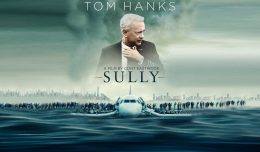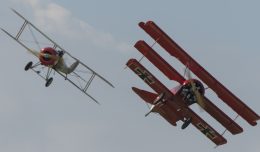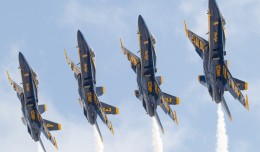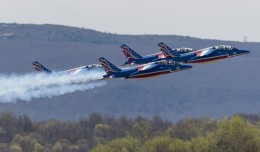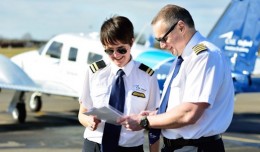Fornof and Airplanes
Upon learning Fornof was unable to get drafted, his admiral friend told him they would figure out something else. About six months later, a solution presented itself. The admiral told Fornof the Navy thought it would be good if Fornof evaluated the test pilot school.
“I got to go through all the flying qualities, which is what you really want to do,” he said. “I got to fly everything the Navy had. ”
The test pilot school added some fast jets to his logbook, but of everything he’s flown, Fornof still calls the F-8 Bearcat his favorite.
“Grumman built an airplane that was really only made to get up and get the Kamikaze,” he said. “They made, for fighter pilots, the ultimate sports car. They made a Formula 1 racer for the fighter pilots. It was the most maneuverable, the best climbing and the fastest.”
It’s worth mentioning Fornof appreciated similar qualities on the ground, having purchased a Ferrari several years ago. On the other end of the aircraft spectrum, however, Fornof was quick to note a plane he could live without ever seeing again.
“There were airplanes that I flew, that if I never flew again, I wouldn’t care,” he said. “One of them was the C-119 in a Sylvester Stallone movie. It was good to say I flew it, but I don’t ever have to fly one again. It just shakes and shakes. You can’t even see the instrument panel. You can’t see the instrument panel until you come up on takeoff power. It’s just a blur.”
Despite logging time in so many different aircraft, Fornof said he hasn’t encountered any trouble transitioning from one to another. In fact, as is the case with a lot of his accomplishments, an earlier era made life easier.
“Back in the ‘70s and ‘80s, I would fly sometimes, three different airplanes at an air show,” he said. “We would fly our little jets and then we were flying the Bellanca Viking for the Viking company doing an aerobatic demonstration with their executive airplane, and then a lot of times I had the Bearcat there. So I would fly three shows in one day in three vastly different airplanes. It’s just what I grew up with.”
Though he hasn’t flown several of the modern military fighters, he’s flown aircraft once considered the cutting edge in earlier periods of aviation, including WWII aircraft such as the P-51, F-8 and F-4 Corsair, and Vietnam fighters such as the F-4 Phantom and A-4 Skyhawk.
Through it all, Fornof said he forwent the opportunity to fly just two planes he now wishes he’d flown. Two somewhat-unlikely candidates and both designed for the military, they came to fame through war. One even remains in service. The first, flown by the Germans in WWII, was casually offered to Fornof by a friend in Texas.
“When the CAF was down in Harlingen (Texas), everybody would go down there a week ahead of time, before the show,” he said. “The show was an afterthought. We just had a gathering there every year. Most people were there for seven days. You didn’t have all the insurance problems and this and that. All the guys that had the airplanes were well-qualified with them. Most of them had flown during the war.”
The pilots would fly down, do their photo sessions and engage in really hot dogfights, Fornof said.
“Lefty would say, ‘Go fly the ’38,’ or I’d say, ‘Lefty go fly the Bearcat,’” Fornof said. “It was a true fun weekend where we would fly every day. At the end of the day, we would actually sit under several of the airplanes, the guitars would come out. I played the guitar, several of the guys played the guitar, and we’d sing. A lot of people would drink, and you’d have a blast. Then you’d go down to Mexico and eat dinner.”
At some point during the nonchalant weekend, a friend of Fornof’s named Lefty asked him to fly an ME-109.
“He had just gotten them back,” Fornof said. “They had the No. 3 cylinder on the left side leaking. It was going, ‘drip, drip, drip,’ and on that engine, if you lose all your coolant, you’ve got about 15 seconds before it seizes, so I wasn’t crazy about that and the airplane only had about 45 minutes of fuel to begin with.”
The only other instance of missed opportunity took place in North Carolina at Seymour Johnson Air Force Base.
“I was flying the Mustang,” he said. “The colonel of the base wanted me to take his wife flying in the Mustang. He had flown them in the war. He said, ‘Corkey, if you take her, I’ll get you a ride in the F-4.’ They had an F-4 squadron there. They had one F-4 on the base. The others were in Germany at the time on duty. I thought that was cool. So I took her for a ride and she thoroughly loved it. She went just nuts.”
Fornof went out and strapped in the F-4, but it broke before they could leave. In lieu of the F-4 ride, the colonel offered Fornof what would have become a turn at the controls of a well-known bomber.
Fornof said the colonel offered a 12-hour trip around the North Pole in a B-52. Seymour Johnson had the bombers because it was a SAC base at the time.
“I let my pride get me,” Fornof said. “I said, ‘I’m a fighter pilot. I don’t want to go fly that bomber.’ It’s not something like the B-25 which was part fighter, part bomber. I said, ‘I’ll pass on that.’ I talked with the captain later on and he said, ‘Yeah, we’d have let you fly the airplane,’ and now I wish I had, so I would have had B-52 time.”
Fornof said he’s OK with his decision and hasn’t made any attempt to get back to the cockpit of a B-52.
Many of the airplanes Fornof has flown came through his stunt work. Furthermore, several of his stunts involved flying with unusual, sometimes-dangerous modifications. He designed the stunts he flew and called it one of his fortes. But stunt flying is still rarely a walk in the park as Fornof demonstrated while working on a shoot in Hawaii.
“One of the closest calls I ever had was doing one of Harrison Ford’s movies, ‘Six Days Seven Nights,’” he said.
Fornof explained the director wanted him to fly a seaplane with a lot of junk attached. The script called for the stars to haphazardly attach a set of WWII floats to an small plane which has crash landed, tearing up the gear.
“I told him the airplane really wouldn’t fly like this and against my better judgment, he talked me into testing it,” Fornof said.
“Seaplane is a bad name for seaplanes. They should call them lake airplanes, river airplanes, but not sea, seaplanes because they are not made for the sea. I went ahead and tried this.”
The crew was filming in Lihue Harbor on the Hawaiian island of Kauai. This was to serve as the location for the test.
“I had a nice run to takeoff,” Fornof said. “I had an area I could set down in if it wasn’t going the way I wanted to. I took off with all this garbage, and it amazed me because the airplane shot right up to 60 knots. I got airborne, but the second I went to adjust power to climb power, it just started sinking. It took full power to get it just to 60 knots and anything less than full power, it wouldn’t fly.”
Realizing the airplane wasn’t going to climb properly, Fornof elected to take the early landing option.
“I was going to put it back down in the bay there, and all of a sudden, there were waterskiers and sailboaters that came out from everywhere,” he said, “and there wasn’t a safe place to put it. So now I’m heading out to open sea and whitecaps in the ocean. I’m not about to set it down there, because it would come apart.”
Without a safe place to divert, Fornof did the only thing he could and began a long slow climb.
“I relied on good old’ Pratt and Whitney, the engine manufacturer, and left it at 100 percent takeoff power, 60 knots, it’s heating up quick. As I started to climb,” he said, “I could barely climb 50 feet per minute. If I started to make any turn, the airplane would just sink about 200 feet per minute, so as I’m headed out to sea, I can’t keep going that direction because there’s nothing the direction I’m going, so I’ve got to try to turn to go up the coast. I had to make gradual turns and then climb up a little bit.”
As Fornof headed north up the coast, he traveled about 15 miles before he hit 600 feet, allowing him to come back across the land.
“Growing up in South Louisiana,” he said, “I’d seen a lot of seaplanes that had engine trouble, they’d put them down in the cane fields. They go right with the rows and it works good. So, I knew if I got it back over land I was safe.”
He managed to get the aircraft back over land but the engine was so hot, he said, he could smell it burning.
“I could smell the metal burning and all the redhots were far exceeded. I just prayed the old Pratt and Whitney would hold together,” he said. “We crossed the ridge at about 600 feet going back into the lagoon and the river at Lihue and it took full power to maintain 60 knots downhill. That airplane wasn’t going to go any faster. I was worried about having enough speed to flare, so I started to flare a little high and let it bleed off. After I landed and had pulled the power back just a little, the paint on the cowling had blistered — that’s how hot it was. I was worried about it catching on fire. It just seized. It was literally glowing red.”
Though Fornof was uncomfortable on this flight, these feelings come few and far between. Occasional close calls, high speeds and low altitudes are simply part of his job.
“I’ve done aerobatics so long that it’s second-nature to me,” he said. “I’m comfortable in any position — upside down, right side up. It’s the same being close to the ground.”



